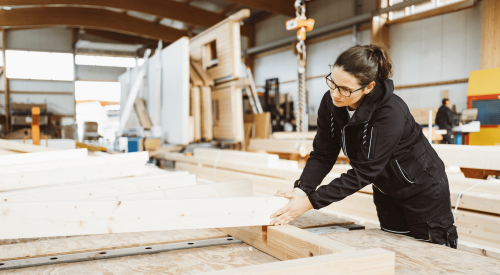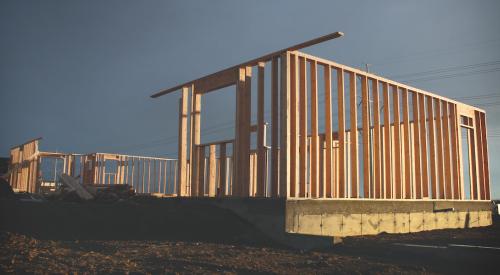Like water, power, and land, labor is a valuable resource, and the shortage of it is a hot topic right now. It’s a large-scale problem that needs a long view, and fortunately, suppliers and manufacturers are starting to address it.
But there’s action you can take right now, from a human resources and systems perspective, to attract and keep more skilled labor: Hire people from outside the industry, train and retain them, improve efficiency, put the skilled labor force to its highest and best use, and take a fresh look at labor-saving materials and processes.
1/ Hire, train, and retain
It used to be that trades had employees perform their work. They would hire unskilled workers and train them on the job. New employees would start doing entry-level tasks with close supervision. As they gained experience, they would move up into more skilled positions. Turnover was low and quality was high. Trades invested in their employees, and the result was that builders could rely on the trade to meet schedule and quality requirements. Not a bad model overall.
Today, too many trades rely on subcontractors, and too many of those subs fail to invest in their workforce. When they do bring new people in, it’s without proper training. And without a clear path for growth, new hires too often quit or get fired. Quality suffers, schedules are missed. As a short-term fix, subcontractors then hire skilled labor from other subcontractors, sometimes right from another builder’s jobsite. (We all know of at least one example where a framer, roofer, drywall hanger, etc., left one jobsite without finishing the work because a competing subcontractor offered him more money. This creates further inefficiencies and doesn’t address the skilled-labor shortage.)
As an industry, we will never be as successful as we could otherwise be if we continue down this path. We need to get back to basics. Builders, encourage your trades to use employees to perform the work instead of hiring subcontractors. Ask that your trades have a program to expand their skilled labor force by hiring unskilled labor and training those workers so they have a path to becoming skilled, valuable members of the team. Encourage suppliers and trades to invest in their employees. Work with them to even-flow your schedules as much as possible so that they’re able to manage the peaks and valleys of their workloads. Share employee training resources when possible. Ask your trades what you can do to support their efforts to stabilize the workforce and increase capacity.
2/ Improve efficiency
Constantly adding new plans and options, continually modifying old plans and options, repetitive adjustment of base house specifications, and frequent change orders after work has begun are the root causes of significant inefficiencies in our industry. For comprehensive efficiency improvement in home building, we need to look at each entity and stage of the process.
• Builders should involve trades in the new-product design process, to ensure efficient designs that work.
• Make sure that construction documents, scopes of work, and specs are accurate and easy to follow. (Show the documents to the suppliers and trades that will be using them.)
• Spend more time up front to ensure that your homes are designed for the target market. This will minimize future product changes.
• Have clear cutoffs and, whenever possible, avoid change orders.
• Plan ahead and minimize peaks and valleys in releasing starts to the field.
• Update your schedule templates and make sure that a home is ready for a trade before that trade shows up at the site.
• Superintendents, be available on-site and walk each home under construction at least twice a day. Engage the people who are actually doing the work. Answer any questions they may have.
• Builders, promptly pay suppliers and trades.
• Suppliers, deliver the right material to the right jobsite at the right time in the right quantity.
3/ Trades, participate in the process
In the midst of a skilled-labor shortage, trades must identify ways to get more from existing resources. As a trade, you’re closest to the process and are best positioned to make that happen. Ask the builder to let you review new product designs and product modifications. After all, you’re going to be the one required to build it. Get involved up front so you can have a say in the constructability of the home. Develop rough-cut capacity planning tools and a finite schedule to identify future bottlenecks, and address bottlenecks before schedules are missed. Ask for supervision on the jobsite to ensure that work is being performed to standard. Stop any installation not being performed to standard before additional labor is wasted on what will later be rework. Show up on time and complete the assigned task within the allotted schedule. Be vigilant about preventing damage to other trades’ completed work. Leave the jobsite clean and ready for the next trade. Talk with the trade that comes in before you and the one that comes in after. Identify ways to maximize one another’s skilled resources.
4/ Put labor resources to their highest and best use
Stop using skilled labor to complete unskilled tasks. Where possible, hire labor from outside our industry to perform unskilled tasks; it’s an approach that can work for most trades and it helps you to get more from your skilled labor. (How often do you see a mason mix his own mortar or carry his own brick? This work typically can be done by an apprentice or junior-level employee, allowing the skilled mason to lay more brick in less time.) Look at areas on your jobsite where skilled labor can be better utilized. Talk to your trades about shadow programs that empower their most skilled employees to train less-experienced members of the team. Workers who enjoy and are good at training others are a valuable asset in easing the labor crunch.
5/ Use labor-saving materials and processes
Certain products on the market are proven time-savers. Assess them on a net-cost basis. They may cost a bit more, but if labor savings and increased capacity offset that cost, you may get more done with the skilled labor you have available to you. Let’s use framing as an example. Rather than stick-frame a home, consider using panels, trusses, prefabricated stairs, and floor systems. These components can be assembled in a factory by employees who may not have the skills to frame a house but are adept at component-building. If your framer can assemble the components in two-thirds of the time it would take to do traditional framing, this translates to framing a third more homes.
These efficiency initiatives take effort from every member of the value chain: manufacturers, suppliers, trades, and builders. We’ve resolved labor issues in home building before, and we can do it again.













